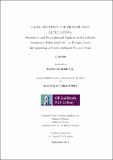| dc.description.abstract | Excimer lasers have proven to be a useful tool for the precision removal of thin layers of polymer material. With the advent of polymer microfluidics, excimer lasers may have a role to play in the production of small volume prototype devices. However, there are limitations associated with excimer machining, in particular, scanning laser ablation through a static mask. This thesis presents a method to overcome these limitations using a dynamic variable aperture in place of the static mask on the excimer laser system. The dynamic, or intelligent, pinhole mask (IPM) can be used to overcome some of the drawbacks to traditional scanning laser ablation. Beam reconfiguration techniques are developed and used to produce complex microchannel geometries. A validated predictive model, incorporating variables for the laser, IPM, scanning stage and material ablation rate, greatly reduces the time required on the laser, thus reducing the design to final device realisation time. Using the laser system and predictive model, microfluidic mixing channels are developed. The mixers are based on 2D and 3D baffle geometries producible by precise control of the IPM opening during the machining process. The mixing channels are first developed offline using a combination of the predictive model and computational fluid dynamics (CFD) to refine channel geometry prior to the fabrication step. A designed experiment is used to reduce the number of CFD simulations required in order to reach the optimised microchannel geometry. The mixers use the principle of induced chaotic advection to combine initially separate fluid streams efficiently over a short distance. Both mixers demonstrate high mixing efficiency in comparison to a standard T-mixer over a Reynolds number (Re) range from 0.1 to 20. At a Re of 0.1, 90% mixing is achieved in a path length of 32 mm and 7 mm, for the 2D and 3D mixers, respectively. This represents an improvement in performance over a standard T-mixer of 20% for the 2D mixer and 82.5% for the 3D mixer. Finally, the 3D mixer is incorporated into a functional microfluidic device prototype. Using this prototype, on-chip hybridisation of a synthetic bacterial sample is successfully demonstrated. | en_US |


